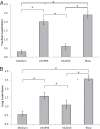Attenuated Phenotype of a Recent House Finch-Associated Mycoplasma gallisepticum Isolate in Domestic Poultry
- PMID: 28396323
- PMCID: PMC5442625
- DOI: 10.1128/IAI.00185-17
Attenuated Phenotype of a Recent House Finch-Associated Mycoplasma gallisepticum Isolate in Domestic Poultry
Abstract
Mycoplasma gallisepticum, known primarily as a respiratory pathogen of domestic poultry, has emerged since 1994 as a significant pathogen of the house finch (Haemorhousmexicanus) causing severe conjunctivitis and mortality. House finch-associated M. gallisepticum (HFMG) spread rapidly and increased in virulence for the finch host in the eastern United States. In the current study, we assessed virulence in domestic poultry with two temporally distant, and yet geographically consistent, HFMG isolates which differ in virulence for house finches-Virginia 1994 (VA1994), the index isolate of the epidemic, and Virginia 2013 (VA2013), a recent isolate of increased house finch virulence. Here we report a significant difference between VA1994 and VA2013 in their levels of virulence for chickens; notably, this difference correlated inversely to the difference in their levels of virulence for house finches. VA1994, while moderately virulent in house finches, displayed significant virulence in the chicken respiratory tract. VA2013, while highly virulent in the house finch, was significantly attenuated in chickens relative to VA1994, displaying less-severe pathological lesions in, and reduced bacterial recovery from, the respiratory tract. Overall, these data indicate that a recent isolate of HFMG is greatly attenuated in the chicken host relative to the index isolate, notably demonstrating a virulence phenotype in chickens inversely related to that in the finch host.
Keywords: Mycoplasma gallisepticum; chicken; house finch; pathology; virulence.
Copyright © 2017 American Society for Microbiology.
Figures




Similar articles
-
Differential house finch leukocyte profiles during experimental infection with Mycoplasma gallisepticum isolates of varying virulence.Avian Pathol. 2020 Aug;49(4):342-354. doi: 10.1080/03079457.2020.1753652. Epub 2020 May 18. Avian Pathol. 2020. PMID: 32270701 Free PMC article.
-
Extensive variation in surface lipoprotein gene content and genomic changes associated with virulence during evolution of a novel North American house finch epizootic strain of Mycoplasma gallisepticum.Microbiology (Reading). 2012 Aug;158(Pt 8):2073-2088. doi: 10.1099/mic.0.058560-0. Epub 2012 May 24. Microbiology (Reading). 2012. PMID: 22628486
-
Further western spread of Mycoplasma gallisepticum infection of house finches.J Wildl Dis. 2006 Apr;42(2):429-31. doi: 10.7589/0090-3558-42.2.429. J Wildl Dis. 2006. PMID: 16870870
-
Response of black-capped chickadees to house finch Mycoplasma gallisepticum.PLoS One. 2015 Apr 16;10(4):e0124820. doi: 10.1371/journal.pone.0124820. eCollection 2015. PLoS One. 2015. PMID: 25880849 Free PMC article.
-
Dynamics of a novel pathogen in an avian host: Mycoplasmal conjunctivitis in house finches.Acta Trop. 2005 Apr;94(1):77-93. doi: 10.1016/j.actatropica.2005.01.009. Acta Trop. 2005. PMID: 15777638 Review.
Cited by
-
Differing House Finch Cytokine Expression Responses to Original and Evolved Isolates of Mycoplasma gallisepticum.Front Immunol. 2018 Jan 22;9:13. doi: 10.3389/fimmu.2018.00013. eCollection 2018. Front Immunol. 2018. PMID: 29403495 Free PMC article.
-
Pathogenic avian mycoplasmas show phenotypic differences in their biofilm forming ability compared to non-pathogenic species in vitro.Biofilm. 2024 Mar 6;7:100190. doi: 10.1016/j.bioflm.2024.100190. eCollection 2024 Jun. Biofilm. 2024. PMID: 38515541 Free PMC article.
-
Differential house finch leukocyte profiles during experimental infection with Mycoplasma gallisepticum isolates of varying virulence.Avian Pathol. 2020 Aug;49(4):342-354. doi: 10.1080/03079457.2020.1753652. Epub 2020 May 18. Avian Pathol. 2020. PMID: 32270701 Free PMC article.
-
Occurrence of Mycoplasma gallisepticum in wild birds: A systematic review and meta-analysis.PLoS One. 2020 Apr 16;15(4):e0231545. doi: 10.1371/journal.pone.0231545. eCollection 2020. PLoS One. 2020. PMID: 32298318 Free PMC article.
-
Variable Lipoprotein Hemagglutinin A Gene (vlhA) Expression in Variant Mycoplasma gallisepticum Strains In Vivo.Infect Immun. 2018 Oct 25;86(11):e00524-18. doi: 10.1128/IAI.00524-18. Print 2018 Nov. Infect Immun. 2018. PMID: 30181349 Free PMC article.
References
-
- Raviv Z, Ley DH. 2013. Mycoplasma gallisepticum infection, p 1423 In Glisson JR, McDougald LR, Swayne DE, Nolan LK, Suarez DL, Nair V (ed), Diseases of poultry, 13th ed Wiley, Ames, IA.
Publication types
MeSH terms
Grants and funding
LinkOut - more resources
Full Text Sources
Other Literature Sources

